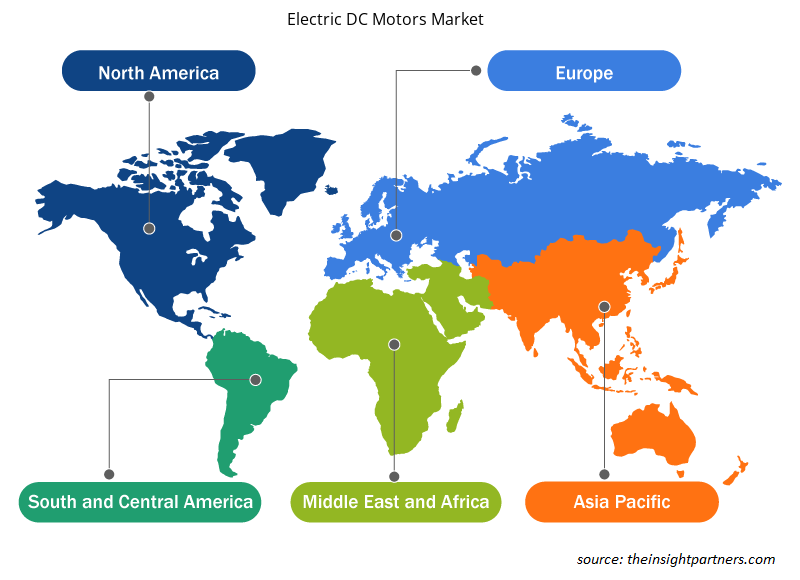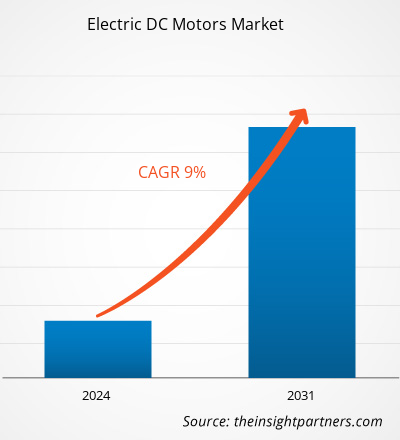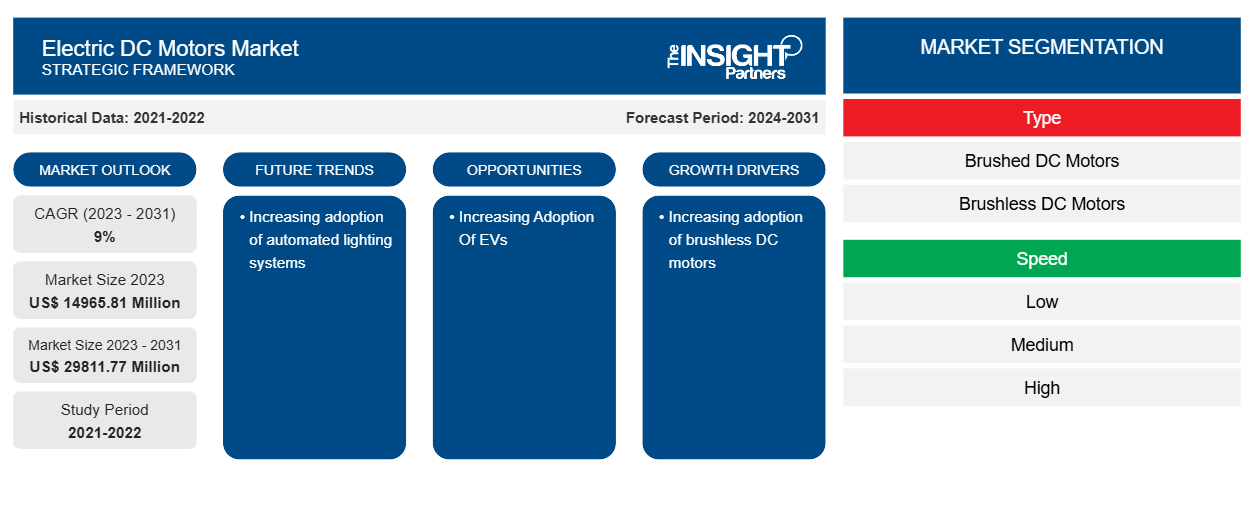Der Markt für Gleichstrommotoren soll von 14.965,81 Millionen US-Dollar im Jahr 2023 auf 29.811,77 Millionen US-Dollar im Jahr 2031 anwachsen. Der Markt soll zwischen 2023 und 2031 eine durchschnittliche jährliche Wachstumsrate (CAGR) von 9 % verzeichnen. Die zunehmende Einführung automatisierter Beleuchtungssysteme dürfte ein wichtiger Trend auf dem Markt bleiben.
Marktanalyse für elektrische Gleichstrommotoren
Heizungs-, Lüftungs- und Klimaanlagen (HLK) sorgen für eine gute Luftqualität und thermischen Komfort. Das US-Energieministerium schätzt, dass die Nachfrage nach HLK-Geräten im Jahr 2021 um 10 % höher war als im Jahr 2020. HLK-Systeme sind ein entscheidender Bestandteil moderner Infrastruktur, insbesondere in großen Bürogebäuden und Einkaufszentren. In HLK-Systemen werden häufig elektrische Gleichstrommotoren eingesetzt, um deren Lebensdauer, Leistung und Luftstromeffizienz zu erhöhen. Die Erweiterung von Gewerbeflächen, der Bau neuer Unternehmenszentralen, Bürogebäude, Einzelhandelsgeschäfte und Wohnkomplexe sowie das steigende Einkommensniveau in den Ländern Südostasiens und des Nahen Ostens und Asiens haben HLK-Geräte für Verbraucher sehr erschwinglich gemacht.
Marktübersicht für elektrische Gleichstrommotoren
Eine Art elektrischer Maschine, die elektrische Energie in mechanische Energie umwandelt, ist ein Gleichstrommotor. Gleichstrommotoren verwenden Gleichstrom, um aus der Energie, die sie erhalten, eine mechanische Drehung zu erzeugen. Gleichstrommotoren verwenden Magnetfelder, die durch die durch sie fließenden elektrischen Ströme erzeugt werden, um einen Rotor anzutreiben, der in der Ausgangswelle befestigt ist. Sowohl der elektrische Eingang als auch das Design des Motors wirken sich auf das Drehmoment und die Drehzahl des Ausgangs aus. Ein Stator und ein Anker sind die beiden Hauptteile eines Gleichstrommotors. In einem Motor dreht sich der Anker, während der Stator bewegungslos bleibt. Der Anker eines Gleichstrommotors dreht sich aufgrund des vom Stator erzeugten Magnetfelds. Ein einfacher Gleichstrommotor erzeugt ein elektromagnetisches Feld, das auf die Mitte der Spule ausgerichtet ist, indem er eine strombetriebene Drahtspule und einen Satz stationärer Magnete im Stator verwendet.
Passen Sie diesen Bericht Ihren Anforderungen an
Sie erhalten kostenlos individuelle Anpassungen an jedem Bericht, einschließlich Teilen dieses Berichts oder einer Analyse auf Länderebene, eines Excel-Datenpakets sowie tolle Angebote und Rabatte für Start-ups und Universitäten.
-
Holen Sie sich die wichtigsten Markttrends aus diesem Bericht.Dieses KOSTENLOSE Beispiel umfasst eine Datenanalyse von Markttrends bis hin zu Schätzungen und Prognosen.
Markttreiber und Chancen für elektrische Gleichstrommotoren
Zunehmende Verbreitung bürstenloser Gleichstrommotoren
Die Verbreitung bürstenloser Gleichstrommotoren nimmt zu, da verschiedene Unternehmen diese Motoren auf den Markt bringen. So hat Portescap im Januar 2021 seine Plattform für bürstenlose Gleichstrommotoren Ultra EC™ mini um den bürstenlosen Hochgeschwindigkeitsmotor 16ECS erweitert. Diese kompakten 16-Millimeter-Motoren sind in den Längen 36 und 52 mm erhältlich und bieten hohe Leistung bei Drehzahlen von 75.000 U/min. Ebenso kündigte Johnson Electric im Februar 2023 die Einführung unserer bürstenlosen Gleichstrommotorplattform ECI-043 an. Mit der Einführung bürstenloser Gleichstrommotoren wächst der Markt also.brushless DC motors is increasing as various companies are launching these motors. For instance, in January 2021, Portescap added the 16ECS high-speed brushless motor to its Ultra EC™ mini brushless DC motor platform. These compact 16-millimeter motors are available in 36- and 52-mm lengths and provide brushless DC motor platform. Thus, with the introduction of brushless DC motors, the market is growing.
Zunehmende Verbreitung von ElektrofahrzeugenEVs
Einige der weltweit größten Automobilhersteller, deren Produktionsstätten in den verschiedenen amerikanischen Regionen Pkw, Lkw, Busse und andere Geländefahrzeuge herstellen, haben verschiedene Elektrifizierungsinitiativen gestartet. So hatte Stellantis im Juli 2021 geplant, bis 2025 rund 35,5 Milliarden US-Dollar in die Elektrifizierung von Fahrzeugen zu investieren. Darüber hinaus schließt sich Stellantis Automobilherstellern wie General Motors, Volkswagen und Ford Motor an und hat Investitionen in Höhe von mehreren zehn Milliarden Dollar in Elektrofahrzeuge angekündigt. Der US-Bundesstaat Kalifornien, einer der weltweit größten Automobilproduktionsstandorte, hat begonnen, Automobilherstellern Anreize und Auflagen für emissionsfreie Fahrzeuge zu bieten. So verabschiedete das California Air Resources Board im August 2022 die bahnbrechende Verordnung Advanced Clean Cars II, um den Verkauf von 100 % emissionsfreien Neufahrzeugen bis 2035 zu beschleunigen. Die zunehmende Verbreitung von Elektrofahrzeugen schafft also mehr Chancen für den Markt.OEMs, manufacturing plants established in the various American regions that manufacture passenger cars, trucks, buses, and other off-highway vehicles, have undertaken various electrification initiatives. For instance, in July 2021, Stellantis had planned to invest around US$35.5 billion in vehicle electrification through 2025. Furthermore, Stellantis joins automakers such as General Motors, Volkswagen, and Ford Motor in announcing investments of tens of billions of dollars in EVs. California state in the US, one of the world's largest automotive manufacturing hubs, has started providing incentives and mandates to automotive OEMs for zero-emission vehicles. For instance, in August 2022, The California Air Resources Board approved the trailblazing Advanced Clean Cars II regulation to accelerate 100% new zero-emission vehicle sales by 2035. Thus, the increasing adoption of EVs is creating more opportunities for the market.
Segmentierungsanalyse des Marktberichts für Gleichstrommotoren
Wichtige Segmente, die zur Ableitung der Marktanalyse für elektrische Gleichstrommotoren beigetragen haben, sind Typ, Geschwindigkeit und Anwendung.
- Basierend auf dem Typ ist der Markt für elektrische Gleichstrommotoren in bürstenbehaftete Gleichstrommotoren und bürstenlose Gleichstrommotoren unterteilt. Das Segment der bürstenlosen Gleichstrommotoren hatte im Jahr 2023 einen größeren Marktanteil.Brushless DC Motors. The Brushless DC Motors segment held a larger market share in 2023.
- Nach Geschwindigkeit ist der Markt in niedrig, mittel und hoch segmentiert.
- Nach Anwendung ist der Markt in Industriemaschinen, Automobil und Transport, HLK-Ausrüstung, Luft- und Raumfahrt und Verteidigung, Haushaltsgeräte und Sonstiges segmentiert.HVAC equipment, aerospace & defense, household appliances, and others.
Marktanteilsanalyse für Gleichstrommotoren nach geografischer Lage
Der geografische Umfang des Marktberichts für elektrische Gleichstrommotoren ist hauptsächlich in fünf Regionen unterteilt: Nordamerika, Asien-Pazifik, Europa, Naher Osten und Afrika sowie Süd- und Mittelamerika.
APAC dominiert den Markt für Gleichstrommotoren. Der Markt für Gleichstrommotoren wächst in dieser Region aufgrund verschiedener Faktoren, wie z. B. zunehmender staatlicher Initiativen zur Verbesserung der Sichtbarkeit der Tunnelbeleuchtung und der Präsenz einer gut etablierten Transportbranche.
Regionale Einblicke in den Markt für Gleichstrommotoren
Die regionalen Trends und Faktoren, die den Markt für Gleichstrommotoren im Prognosezeitraum beeinflussen, wurden von den Analysten von Insight Partners ausführlich erläutert. In diesem Abschnitt werden auch die Marktsegmente und die Geografie für Gleichstrommotoren in Nordamerika, Europa, im asiatisch-pazifischen Raum, im Nahen Osten und Afrika sowie in Süd- und Mittelamerika erörtert.

- Erhalten Sie regionale Daten zum Markt für Gleichstrommotoren
Umfang des Marktberichts über elektrische Gleichstrommotoren
| Berichtsattribut | Details |
|---|---|
| Marktgröße im Jahr 2023 | 14965,81 Millionen US-Dollar |
| Marktgröße bis 2031 | 29811,77 Millionen US-Dollar |
| Globale CAGR (2023 - 2031) | 9 % |
| Historische Daten | 2021-2022 |
| Prognosezeitraum | 2024–2031 |
| Abgedeckte Segmente |
Nach Typ
|
| Abgedeckte Regionen und Länder |
Nordamerika
|
| Marktführer und wichtige Unternehmensprofile |
|
Marktteilnehmerdichte für Gleichstrommotoren: Auswirkungen auf die Geschäftsdynamik verstehen
Der Markt für elektrische Gleichstrommotoren wächst rasant, angetrieben durch die steigende Nachfrage der Endnutzer aufgrund von Faktoren wie sich entwickelnden Verbraucherpräferenzen, technologischen Fortschritten und einem größeren Bewusstsein für die Vorteile des Produkts. Mit steigender Nachfrage erweitern Unternehmen ihr Angebot, entwickeln Innovationen, um die Bedürfnisse der Verbraucher zu erfüllen, und nutzen neue Trends, was das Marktwachstum weiter ankurbelt.
Die Marktteilnehmerdichte bezieht sich auf die Verteilung von Firmen oder Unternehmen, die in einem bestimmten Markt oder einer bestimmten Branche tätig sind. Sie gibt an, wie viele Wettbewerber (Marktteilnehmer) in einem bestimmten Marktraum im Verhältnis zu seiner Größe oder seinem gesamten Marktwert präsent sind.
Die wichtigsten auf dem Markt für Gleichstrommotoren tätigen Unternehmen sind:
- ABB
- Allied Motion Inc.
- Ametek Inc
- Yaskawa Electric Corp
- Minebeamitsumi Inc.
- Johnson Electric Holdings Limited
Haftungsausschluss : Die oben aufgeführten Unternehmen sind nicht in einer bestimmten Reihenfolge aufgeführt.

- Überblick über die wichtigsten Akteure auf dem Markt für Gleichstrommotoren
Marktnachrichten und aktuelle Entwicklungen zu elektrischen Gleichstrommotoren
Der Markt für elektrische Gleichstrommotoren wird durch die Erhebung qualitativer und quantitativer Daten aus Primär- und Sekundärforschung bewertet, die wichtige Unternehmensveröffentlichungen, Verbandsdaten und Datenbanken umfasst. Nachfolgend sind einige der Entwicklungen auf dem Markt für elektrische Gleichstrommotoren aufgeführt:
- Johnson Electric hat die Markteinführung unserer bürstenlosen Gleichstrommotorplattform ECI-040 angekündigt. Diese neue Generation soll die Integration vereinfachen, indem sie über den Controller direkten Wechselstrom aus dem Netz als Eingang akzeptiert. Kunden können Wechselstrommotoren direkt ersetzen und zudem auf teure und große AC -DC-Transformatoren verzichten . (Quelle: Johnson Electric, Pressemitteilung, August 2021)
- Nidec Corporation gab bekannt, dass es einen einphasigen, vibrationsarmen und kostengünstigen bürstenlosen Gleichstrommotor entwickelt hat, der in einen elektrischen Ventilator eingebaut werden kann. Die meisten elektrischen Ventilatoren auf der ganzen Welt verwenden kostengünstige AC-Motoren (Kondensatormotoren), die als Lösung für den weltweiten Anstieg des Energieverbrauchs durch hocheffiziente bürstenlose Gleichstrommotoren ersetzt werden sollten. Während dreiphasige bürstenlose Gleichstrommotoren eine hervorragende Haltbarkeit, Geräuschentwicklung und Steuerbarkeit aufweisen, sind sie aufgrund ihres höheren Preises als Wechselstrommotoren teuer und stellen ein Hindernis für den Ersatz von AC-Gleichstrommotoren dar. (Quelle: Nidec Corporation, Pressemitteilung, September 2022)
Marktbericht zu elektrischen Gleichstrommotoren – Abdeckung und Ergebnisse
Der Bericht „Marktgröße und Prognose für elektrische Gleichstrommotoren (2021–2031)“ bietet eine detaillierte Analyse des Marktes, die die folgenden Bereiche abdeckt:
- Marktgröße und Prognose für Gleichstrommotoren auf globaler, regionaler und Länderebene für alle wichtigen Marktsegmente, die im Rahmen des Projekts abgedeckt sind
- Markttrends für elektrische Gleichstrommotoren sowie Marktdynamik wie Treiber, Einschränkungen und wichtige Chancen
- Detaillierte PEST/Porters Five Forces- und SWOT-Analyse
- Marktanalyse für elektrische Gleichstrommotoren mit den wichtigsten Markttrends, globalen und regionalen Rahmenbedingungen, wichtigen Akteuren, Vorschriften und aktuellen Marktentwicklungen
- Branchenlandschaft und Wettbewerbsanalyse, die die Marktkonzentration, Heatmap-Analyse, prominente Akteure und aktuelle Entwicklungen auf dem Markt für elektrische Gleichstrommotoren umfasst
- Detaillierte Firmenprofile
- Historische Analyse (2 Jahre), Basisjahr, Prognose (7 Jahre) mit CAGR
- PEST- und SWOT-Analyse
- Marktgröße Wert/Volumen – Global, Regional, Land
- Branchen- und Wettbewerbslandschaft
- Excel-Datensatz
Aktuelle Berichte
Erfahrungsberichte
Grund zum Kauf
- Fundierte Entscheidungsfindung
- Marktdynamik verstehen
- Wettbewerbsanalyse
- Kundeneinblicke
- Marktprognosen
- Risikominimierung
- Strategische Planung
- Investitionsbegründung
- Identifizierung neuer Märkte
- Verbesserung von Marketingstrategien
- Steigerung der Betriebseffizienz
- Anpassung an regulatorische Trends























 Kostenlose Probe anfordern für - Markt für elektrische Gleichstrommotoren
Kostenlose Probe anfordern für - Markt für elektrische Gleichstrommotoren